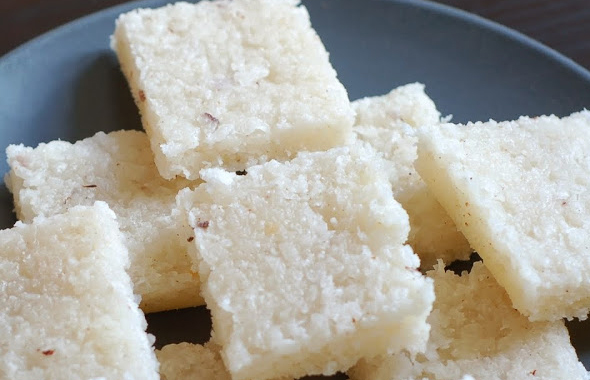Mama’s Punjabi Recipes – Coconut di Burfi (Coconut Milk Squares)
Burfi is one of the most common and popular confections in India and is widely available all over India. It’s a favorite of little kids in particular as they can gobble up the burfi pieces which are cut into squares or diamond shapes. When my kids were little, they would call my younger brother burfi bhapa (burfi uncle) since he would always bring burfi when he would come to see them. That name stuck to him till the kids went through high school!!
And burfi comes in all varieties too, from the plain condensed milk version to the pista (pistachio), badam (almond) or kajju (cashew). It can be plain with the top coated with a very fine film of real silver or gold, which was the way it was displayed and served in the olden days. Nowadays, the burfi is just as apt to be coated with a layer of dark chocolate which young kids just adore.
The old-fashioned way to make burfi is to take whole milk (in India, they use water buffalo milk which is heavy with cream} and then let it boil on a stove till it has evaporated down to a thick cream. It’s a time consuming process that requires patience, a lot of supervision to stir the milk so that it doesn’t stick to the bottom and burn, and the ability to stand over a hot stove for long hours. It many traditional halwai’s (confectioner’s) shops, this is still the way burfi is made.
But if you go to the larger franchise stores, it’s more mechanized and some of the hard labor is cut down. This recipe allows the average home cook to cut back the work and still make a tasty burfi that can match the store made ones. It is quick and easy to make – in about 30 minutes – and those who eat it will never know the difference.
Ingredients:
1 cup non-fat milk powder
½ cup bariq narrial (fine coconut)
¼ cup bariq chinni (fine sugar)
1 tbsp doodh (milk) – whole or non-fat per your choice
Directions:
1. Pour all the ingredients in a bowl and mix thoroughly.
2. Pour in the milk and mix thoroughly and knead till it forms into a ball. Coat your hands with some vegetable oil so that the ball will not stick.
3. Coat a clean dinner plate with a thin film of vegetable oil so that the burfi will not stick.
4. Take the ball out and place on the dinner plate.
5. Use a velna (rolling pin) to spread the ball on the plate into a ½ thick flat pancake.
6. Cover with some wrapping paper and place the plate in the fridge for an hour.
7. Remove from fridge and then cut the pancake into 1.5 inch square or diamond shapes and serve.
Shakuntla Malhotra is a skilled cook of Punjabi dishes made in the old-fashioned style that she learnt as a young woman in her ancestral home in Lyallpur, India before it became part of Pakistan after the Partition in 1947. People have often admired her cooking for its simplicity and taste that comes with each mouthful. Even in her mid-eighties, she continues to cook daily and agreed to share some of her delectable Punjabi recipes.
MAMA’S TIP OF THE WEEK
WEAR LATEX GLOVES WHILE CUTTING HOT OR HATCH PEPPERS, GINGER OR GARLIC
Lots of onions, ginger, garlic and peppers are used in Indian cooking to bring out the aromatic flavors in the recipes, and many dishes are served with sliced raw onions too. But these garnishes and ingredients can be hard on the hands, especially if you peel and cut a lot of them. The enzymes in them coat the skin and make your hands and fingers sting, burn or itch. This is most evident when you cut red or green peppers or the popular summertime hatch peppers.
Even washing your hands with soap or using hand cream sometimes doesn’t take the sting away. And, you could just as easily touch your eyes, nose or ears and transfer the enzyme to those areas. As a precaution against this kind of skin irritation, it is best to use thin latex gloves while cutting these garnishes and this will keep your hands from burning or itching.


